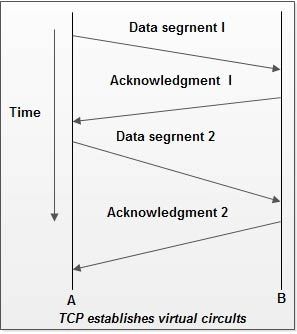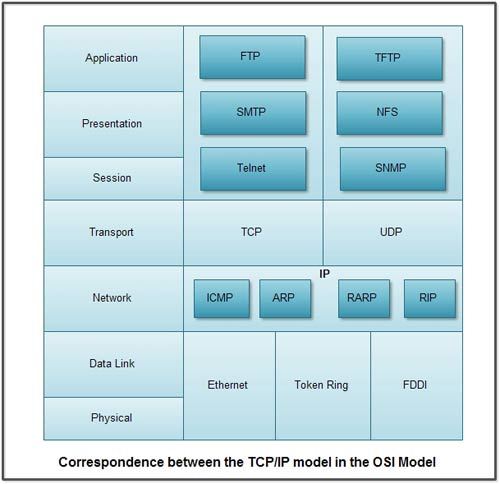In 1969, the Advanced Research Projects Agency (ARPA), belonging to the United States Department of Defense, funded a project. ARPA established a network of switching packets of computers connected through rented point-to-point lines called the Network of the Agency for Advanced Research Projects (ARPANET), which provided the basis for the first investigations in network interconnection. The conventions developed by ARPA to specify how individual computers could communicate over the network became TCP / IP.
The TCP / IP protocol, acronym for Transmission Control Protocol / Internet Protocol, protocols used to control Internet transmission. It allows different types of computers or computers to communicate through heterogeneous networks.
An Internet under TCP / IP operates as a single network that connects many computers of any size and shape. Internally, the Internet is an interconnection of independent physical networks (such as LANs) connected by network interconnection devices. The figure shows the topology of a possible Internet. In this example, the letters A, B, C, and others represent stations. A station in TCP / IP is a computer. The solid circles of the figures numbered as 1, 2, 3, etc., are routers or gateways. Larger ovals containing Roman numerals (I, II, III, etc.) represent different physical networks.
For TCP / IP, the Internet itself seems quite different (see the figure again). TCP / IP considers all interconnected physical networks as a vast network. It considers that all stations connected to this sizeable logical network instead of their respective physical networks.
The TCP protocol developed before the OSI model. Therefore the levels of the TCP / IP protocol do not match precisely those of the OSI model. The TCP / IP protocol consists of five levels: physical, data link, network, transport, and application. The application level in TCP / IP can consider as a combination of the session, presentation, and application levels of the OSI model.
At the transport level, TCP / IP defines two protocols: TCP and the user datagram protocol (UDP). At the network level, the primary protocol defined by TCP / IP is the inter-network (IP) protocol, although some other protocols support data transfer at this level.
At the physical and data link levels, TCP / IP does not define any specific protocol. It supports all standard protocols. A TCP / IP network can be a local area network (LAN), a metropolitan area network (MAN) or a wide area network (WAN).
TCP / IP is a hierarchical protocol composed of interactive modules, each of which provides specific functionality, but which are not necessarily interdependent. While the OSI model specifies which functions belong to each of its levels, the levels of the TCP / IP family of protocols contain relatively interdependent protocols that can be mixed and matched depending on the needs of the system. The term hierarchical means that one or more lower-level protocols support each upper-level protocol.
We’ll be covering the following topics in this tutorial:
Feature of TCP/IP protocol
TCP– It provides a connection type service. That is, a logical connection must be established prior to communication. Because of this, continuous transmission of large amount of data is possible. It ensures a highly reliable data transmission for upper layers using IP protocol. This is possible because TCP uses positive acknowledgement to confirm the sender about the proper reception of data. The sender keeps on sending data at constant intervals until it receives a positive acknowledgment.
A negative acknowledgment implies that the failed data segment needs to be retransmitted.
What happens when a packet is lost on the network and fails to reach its ultimate destination? When host A sends data, it starts a countdown timer. If the timer expires without receiving an acknowledgment, host A assumes that the data segment was lost consequently, host A retransmits a duplicate of the failing segment.
This has also other functions like sequence control, error recovery and control, flow control and identification of port number.

The TCP header includes both source and destination port fields for identifying the applications for which the connection is established. The sequence and acknowledgment Number fields underlie the positive acknowledgment and retransmission technique. Integrity checks are accommodated using the checksum field.
 IP-In contrast to TCP, it is a connection less type service and operates at third layer of OSI reference model. That is, prior to transmission of data, no logical connection is needed. This type of protocol is suitable for the sporadic transmission of data to a number of destinations. This has no functions like sequence control, error recovery and control, flow control but this identifies the connection with port number.
IP-In contrast to TCP, it is a connection less type service and operates at third layer of OSI reference model. That is, prior to transmission of data, no logical connection is needed. This type of protocol is suitable for the sporadic transmission of data to a number of destinations. This has no functions like sequence control, error recovery and control, flow control but this identifies the connection with port number.
From the above it seems that TCP/IP may be considered as two separate protocols, i.e. TCP and IP. However, TCP actually refers to multiple protocols employed for communications using IP. Therefore, TCP/IP is also referred to as the TCP/IP protocol suit.

Difference Between TCP/IP and OSI Model
The OSI and TCP / IP reference models have much in common. Both of these based on the concept of a large number of independent protocols. Also, the Layer functionality is very similar. For example, in both models, the layers above the transport, including this one, are there to provide a service from end-to-end transport, regardless of the network, to the processes that they want to communicate. These layers form the transport provider. Also, in both models, the layers above the transport are transport service users application-oriented.
Despite these fundamental similarities between the two models, there are also many differences.
In the OSI model, a clear distinction made between service, interface, and protocol. In the TCP / IP model, this distinction is not so clear, although we have tried to readjust it later to make it more similar to OSI. As a consequence of this in the model
OSI protocols are better hidden than in the TCP / IP model and can be replaced with relative ease when changing technology.
The OSI model developed before the protocols invented. It means that the model not oriented towards a specific set of protocols, which became very general. The wrong side of this order is that the designers did not have much experience with the matter and did not know well what functionality to put in which layer.
The opposite happened in TCP / IP: first, the protocols arrived, and the model was only a description of the existing protocols, so there was no problem of adjusting the protocols to the model. The only problem was that the model not adjusted to any other protocol stack; consequently, it was not very useful to describe other networks that were not of the TCP / IP type.
An obvious difference between both models is the number of layers. In the OSI model there are seven layers and in the TCP / IP model four. Both have layers of (inter) network, transport and application, but the other layers are different.
Another difference is in the area of connectionless communication versus connection-oriented. The OSI model supports both offline and connection-oriented communication in the network layer, but in the transport layer, where it is most important, it does so only with connection-oriented communication. The TCP / IP model has only one mode in the network layer (no connection) but supports both modes in the transport layer, offering an alternative to users — this choice especially for simple request and response protocols.
Criticism of the OSI Model
Why is OSI not implemented worldwide?
• Inopportune appearance: apocalypse of the two elephants.
• Bad technology: both the model and the protocols are complex and abstract, There are two almost empty layers.
• Bad implementations: large, heavy and slow.
• Bad policies: TCP / IP was part of Berkeley’s UNIX.
Criticism of the TCP/IP Model
• There is no distinction between service, interface, and protocol.
• It is not a general model.
• The “layer” of Host to Network is not a layer.
• The physical layer and the link-layer not mentioned.
• Except for TCP, IP the other protocols were made for specific purposes and by both difficult to replace.
 Dinesh Thakur holds an B.C.A, MCDBA, MCSD certifications. Dinesh authors the hugely popular
Dinesh Thakur holds an B.C.A, MCDBA, MCSD certifications. Dinesh authors the hugely popular